Binary Black Holes (BBH)
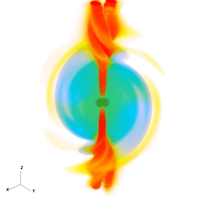 We evolve an orbiting pair of black holes and study their interaction with an electromagnetic field and plasma:
We evolve an orbiting pair of black holes and study their interaction with an electromagnetic field and plasma:
- Magnetospheres of Black Hole Systems in Force-Free Plasma PRD 1007.1198 (2010)
- Dual Jets from Binary Black Holes Science (2010)
- Stirring, not shaking: binary black holes' effects on electromagnetic fields PRL 0905.1121 (2009)
|
Black Hole-Neutron Star Binaries (BHNS)
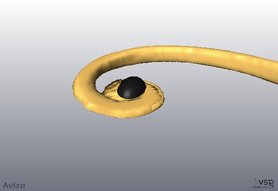 We study the remnant matter and fallback time from the disruption and merger of a neutron star with a black hole:
We study the remnant matter and fallback time from the disruption and merger of a neutron star with a black hole:
- Mergers of Magnetized Neutron Stars with Spinning Black Holes: Disruption, Accretion and Fallback PRL 1006.2839 (2010)
|
Binary Neutron Stars (BNS)
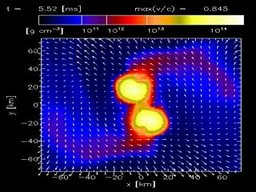 We examine evolutions of orbiting neutron stars looking for the effects
of magnetic field and the equation of state:
We examine evolutions of orbiting neutron stars looking for the effects
of magnetic field and the equation of state:
- Magnetized Neutron-Star Mergers and Gravitational-Wave Signals PRL 0801.4387 (2008)
- Simulating binary neutron stars: dynamics and gravitational waves PRD 0708.2720 (2007)
|
Single Neutron Stars and Black Holes
 We evolve single stars and black holes studying the effect of magnetic field and accretion disk dynamics, as well as using them to test the code.
We evolve single stars and black holes studying the effect of magnetic field and accretion disk dynamics, as well as using them to test the code.
- Dynamics of Rotating, Magnetized Neutron Stars 1002.2217 (2010)
- Evolutions of Magnetized and Rotating Neutron Stars PRD 1001.0575 (2010)
- Post-merger electromagnetic emissions from disks perturbed by binary black holes PRD 0910.4969 (2010)
|
Black Hole Critical Behavior
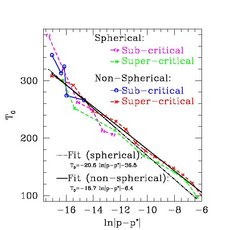 Evolutions of perturbed, unstable stellar solutions suggest Type I critical behavior. Such studies represent one of the rare critical evolutions
in full 3D with no symmetries.
Evolutions of perturbed, unstable stellar solutions suggest Type I critical behavior. Such studies represent one of the rare critical evolutions
in full 3D with no symmetries.
- Dynamics of Rotating, Magnetized Neutron Stars 1002.2217 (2010)
- Evolutions of Magnetized and Rotating Neutron Stars PRD 1001.0575 (2010)
|
Global Existence and Nonlinear Wave Equations
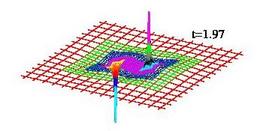 Evolutions of various flatspace, but nonlinear, systems of equations, including wave equations are of interest to mathematicians.
One question in particular is whether a given model allows for the development of singularities from smooth initial data.
Evolutions of various flatspace, but nonlinear, systems of equations, including wave equations are of interest to mathematicians.
One question in particular is whether a given model allows for the development of singularities from smooth initial data.
- Threshold of Singularity Formation in the Semilinear Wave Equation PRD gr-qc/0502056 (2005)
- The Nonlinear Sigma Model With Distributed Adaptive Mesh Refinement CQG gr-qc/0403076 (2004)
- The Singularity Threshold of the Nonlinear Sigma Model Using 3D Adaptive Mesh Refinement PRD gr-qc/0202093 (2002)
|
 We evolve an orbiting pair of black holes and study their interaction with an electromagnetic field and plasma:
We evolve an orbiting pair of black holes and study their interaction with an electromagnetic field and plasma:
 We study the remnant matter and fallback time from the disruption and merger of a neutron star with a black hole:
We study the remnant matter and fallback time from the disruption and merger of a neutron star with a black hole:
 We examine evolutions of orbiting neutron stars looking for the effects
of magnetic field and the equation of state:
We examine evolutions of orbiting neutron stars looking for the effects
of magnetic field and the equation of state:
 We evolve single stars and black holes studying the effect of magnetic field and accretion disk dynamics, as well as using them to test the code.
We evolve single stars and black holes studying the effect of magnetic field and accretion disk dynamics, as well as using them to test the code.
 Evolutions of perturbed, unstable stellar solutions suggest Type I critical behavior. Such studies represent one of the rare critical evolutions
in full 3D with no symmetries.
Evolutions of perturbed, unstable stellar solutions suggest Type I critical behavior. Such studies represent one of the rare critical evolutions
in full 3D with no symmetries.
 Evolutions of various flatspace, but nonlinear, systems of equations, including wave equations are of interest to mathematicians.
One question in particular is whether a given model allows for the development of singularities from smooth initial data.
Evolutions of various flatspace, but nonlinear, systems of equations, including wave equations are of interest to mathematicians.
One question in particular is whether a given model allows for the development of singularities from smooth initial data.